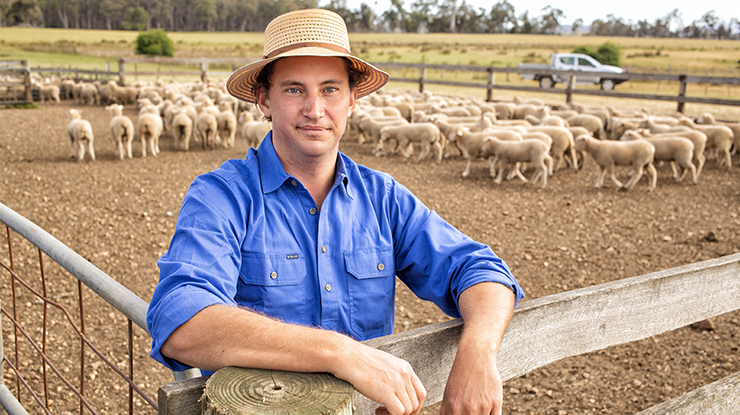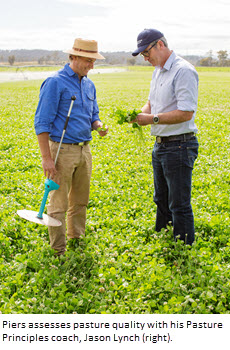 Piers Dumaresq said MLA's Profitable Grazing Systems' Pasture Principles program gave him the tools to drive growth in his business through better management of grass.
Piers Dumaresq said MLA's Profitable Grazing Systems' Pasture Principles program gave him the tools to drive growth in his business through better management of grass.
When Piers Dumaresq returned to his family's Tasmanian farming business in 2013 after 15 years as an economist and professional investor, he expected to easily identify key profit drivers and opportunities for growth.
Instead, he found he needed to learn much more about grass and grazing systems, so he turned to MLA programs to drive a dramatic increase in production and turnover.
As a result, he's lifted ewe numbers from 2,000 to 4,500 without reducing other enterprises in the mixed farming business, which includes poppies, cattle, cropping and pasture production.
Piers started with a Lifetime Ewe Management course and then moved into an MLA Profitable Grazing Systems (PGS) Pasture Principles* program with Macquarie Franklin's Jason Lynch.
While his cropping systems were profitable and stable, limited by rotation and irrigation capacity, he saw the need to grow the sheep business.
"At the time, there were plenty of market signals telling us to produce more lambs," Piers said.
"I believed growing our sheep enterprise would be easy, but in reality I knew nothing about grazing systems or managing pastures.
"It was pretty overwhelming. I quickly realised we had to go back to basics.
"Pasture measurement and feed budgeting are now the two most crucial tools in our business and they drive everything.
"Knowing how to grow and use grass allowed us to grow our business."
Overcoming challenges
As his knowled
 ge of animal feed requirements and plant morphology grew from the PGS program, which uses a mix of group and one‑on‑one learning, Piers identified his first stumbling block – infrastructure.
ge of animal feed requirements and plant morphology grew from the PGS program, which uses a mix of group and one‑on‑one learning, Piers identified his first stumbling block – infrastructure.
"One of the great mental blocks to overcome is thinking you need small paddocks to successfully graze pastures, when really what you need is consistently-sized paddocks."
With paddocks ranging from 5ha to 100ha, the first task was to install more stock water infrastructure and fence larger paddocks into smaller ones, to make each paddock roughly 20ha.
This increased feed utilisation and simplified the grazing system.
"Investing the capital was easily justified with the return on investment exceeding 30% per year."
With better knowledge of plant growth, Piers moved the focus from improving pastures to making existing pastures perform better with well‑managed, timely grazing and good soil nutrition.
He said accurate feed budgets were a powerful tool and enabled him to plan well in advance of requirements to secure additional feed or book stock into processors.
"Pasture Principles, through PGS, gave me the tools to drive growth in our business through better management of grass.
"Business growth would have taken much longer if we hadn't learnt how to budget for feed and manage grazing for full pasture utilisation."
As a new entrant to farming, Pasture Principles helped Piers form networks, learn from other producers and develop a valuable relationship with his coach, Jason Lynch.
"He knows our business and what we're about. We can crunch the numbers and model all likely scenarios as the season shapes up."
Piers is putting his economist hat back on for the next stage of business growth.
While turnover and profitability have increased with growth, the cost of production has risen, so Piers is analysing areas for efficiency gains to return greater profit to the bottom line.






